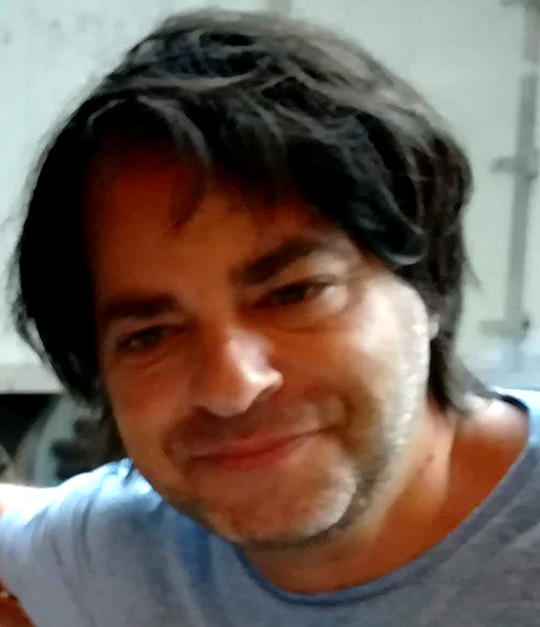
Jon Horvitz
Brain Tutorial Page

Where to start?
I think a good place to start is by touching your own hand. Really. Now realize that you didn't experience the sensation until the touch activated receptors in the skin, and those receptors sent information to the spinal cord, and the spinal cord sent the information to the brain.
The touch receptors are called somatosensory receptors, and they come in different types. Some are sensitive to gentle touch, others to strong touch, still others to pain -- including the pain you feel when you touch a hot stove. (The book discusses the different types of somatosensory receptors, but that's not key here.)
What's interesting to think about here is that you don't feel the touch sensation at the moment that something makes contact with your skin. Instead, the 'feeling' arises from brain activity. And so the brain needs to find out about the touch to your skin.
How does the touch information which begins at the somatosensory receptors in your skin get all the way to the brain? Neurons carry the information. And so understanding what neurons are, and how they carry 'information', becomes key to understanding any inner experience, including the experience of touch. We'll think about neurons a little later.
But before we get to neurons, let's briefly go through the key regions of the brain that you would encounter if you were to travel from the base of the brain (the brainstem), through the brain areas below the cortex (subcortical regions), in order to finally reach the outer layers of the brain, the cerebral cortex, where sensations of touch, hearing, and vision occur.
The Brainstem: Functions critical for life
The brainstem includes the medulla, pons, and midbrain - in that order as you climb above the spinal cord and ascend into the brain.
- The medulla and pons are critical to basic survival functions, including regulation of breathing, heart rate, and blood pressure. Of all brain injuries, severe damage to the medulla and pons are the most life-threatening.
- The midbrain is important in several aspects of behavior, but of particular interest here is the fact that most dopamine neurons originate (have their cell bodies in) the midbrain. As you may know, dopamine neurons play a key role in motivated behavior and addiction. The midbrain also contains two other key regions, the inferior and superior colliculi, described below.
- The cerebellum plays a key role in movement coordination, movement precision, and the ability to learn skilled movements. Alchohol in large quantities may disrupt one's balance and skilled movements in large part because it impairs cerebellar function.
To get a sense of the position of these brainstem structures, take a look here:

On the bottom right, you'll also notice a large cabbage-shaped structure attached to the back of the pons called the cerebellum.
Question 1
Which brainstem structure is directly on top of the spinal cord?
the pons
the cerebellum
medulla
Question 2
What brain area is just above the medulla?
the pons
the midbrain
the hypothalamus
Question 3
What brain area lies just behind the pons?
the medulla
the midbrain
the cerebellum
Try to answer questions 1-3 without looking at a brain image. If you haven't done this yet refresh the page and answer them again.
Subcortical Brain Regions: Motivation, emotion, memory and other functions
If you think of the brainstem as the basement of the brain and the cerebral cortex as the penthouse (we'll get to the cortex), there are a number of important brain structures between the two. For now, we'll consider just five of the most important ones: the hypothalamus, thalamus, hippocampus, amygdala, and basal ganglia.
- The hypothalamus is critical for hunger, thirst, sex drive, and other innate drive states.
- The thalamus receives information from the senses (vision, audition, etc) and passes it on to the cerebral cortex which, in turn, gives rise to the experience of seeing, hearing, etc. It is sometime referred to as a 'relay' station. For example, the neurons in the retina of the eye send visual information to an area of the thalamus that is dedicated to vision, and neurons originating in this thalamic nucleus relay the information to the visual cortex. When you wish to attend to a particular object in the environment, the cortex commands the thalamus to pass on more information about that object to the cortex. For instance, the cortex may decide that it wants to receive more information about the red object behind a bush, and commands the thalamus to send it more visual information about that object.
- The hippocampus plays a key role in memory. Individuals (and animals) who have suffered damage to the hippocampus are greatly impaired in storing and retrieving memories of events they've experienced.
- The amygdala is critical for learning about which environmental situations are dangerous. For instance, if you suffer a physical attack in a particular location, you will learn to be afraid when you pass by that location. Individuals (and animals) with amygdala damage fail to learn associations between environmental stimuli and aversive outcomes. A woman who suffered complete damage to the amygdala on both sides of her brain failed to acquire associations to dangerous stimuli, and showed virutally no signs of fear even in very dangerous situations.
- The basal ganglia are a group of brain structures that play an important role in allowing the behaviors that we frequently perform to become automatized habits. Since so much of our daily behavior involves acquired habits (using silverware, dialing the phone, getting dressed, etc., with little conscious attention required), a loss of basal ganglia function produces great difficulties in behavior. Usually, those with basal ganglia damage can still move, but movement becomes slow and extremely effortful.
Now take a look in Google to find images that include these brain regions. It's possible that you'll have to look at multiple images, for some brain illustrations will only show a subset of them. The idea is not to become a neuroanatomist today -- but to get a feel for where they lie with respect to one another.
Because these five areas are below the cortex, they are called "subcortical areas". when we talk of subcortical areas, we don't usually include the brainstem, even thoughit is below the cortex. When you feel comfortable with the descriptions of these subcortical areas, try the questions below. They're straightforward.
Question 4
Damage to this area can abolish the motivation to eat and drink.
the hypothalamus
the amygdala
the midbrain
Question 5
As you recall what you ate for dinner last night, you are activating your _____.
medulla
basal ganglia
hippocampus
Question 6
This collection of brain structures is needed in order for actions that you repeat many times to become automatized habits.
the thalamus
the basal ganglia
the hippocampus
Review of material so far (brainstem and subcortical regions)
Bob received a gunshot wound to the , an area of the brain housing several brain regions, including the medulla, pons, and midbrain. The injury didn't affect all of these regions. Fortunately, there was no damage to the that sits just above the spinal cord. However, he did suffer damage to the where his dopamine cell bodies (the origin of the dopamine neurons) are located. It's likely he'll survive, but it's possible he'll have particular problems with . If the damage were to his hippocampus, it's likely he'd have had problems with .
brainstem, medulla, midbrain, motivation, memory
Cerebral Cortex: Perception, Action, and Cognition
The cerebral cortex is comprised of lobes that are critical for vision (occipital lobe), audition (temporal lobe), touch or 'somatosensation' (parietal lobe), actions (frontal lobe) and cognition (various lobes, but perhaps the frontal lobe especially). In this drawing,
Cerebral Cortexyou'll notice that in addition to the four lobes, there are pointers to grooves 1) between the left and right hemispheres of the brain (longitudinal fissure), 2) behind the frontal lobe (central sulcus), and 3) above the temporal lobe (lateral sulcus). As you might have guessed from the drawing, the word we use for a groove within the cortical surface is sulcus (sulci, pl.) or fissure. The terms sulcus and fissure are sometimes used interchangeably. For instance the lateral sulcus is sometimes called the Sylvian fissure.
I wouldn't worry about remembering the names of these sulci/fissures at this point. But you should remember that the term sulci (or fissure) refers to grooves in the cortex. You'll notice that the illustration shows many sulci in the cortical surface, with only a few labeled. Also, notice that between sulci, the cortex bulges outward. Each of the bulges between sulci is called a gyrus (gyri, pl.). Take a moment to Google some images for 'sulcus' and 'gyrus' and point to some of the sulci and gyri so you become accustomed to their appearance.
Finally, notice that a few paragraphs above, I said that the central sulcus is behind the frontal lobe. Neuroscientists rarely use the terms 'in front of' or 'behind', but instead say anterior (toward the nose) or posterior (toward the back of the head). So, as you can see in the Cortex illustration, the frontal lobe is anterior to the parietal lobe. The central sulcus and the parietal lobe are posterior to the frontal lobe. Sometimes, instead of anterior vs posterior, you'll see rostral vs caudal. Finally, instead of saying above vs below, we say dorsal vs ventral. So, if you look at the illustration of the cortex, you'll see that the lateral sulcus is dorsal to the temporal lobe, and the temporal lobe is ventral to the lateral sulcus
Review of material so far (cortex, subcortical, and brainstem structures)
You are looking at a tree and the visual experience is due to activity in the lobe. The scene reminds you of a childhood memory which comes to mind thanks to activity of your . You walk to the tree and raise your arm toward a branch. The movement of your arm requires that you activate neurons in your lobe which generates actions. Suddenly you hear a sound. Your immediate detection of the sound -- before you've had a chance to process the details of what the sound is -- involves activation of neurons in an area of the midbrain called the superior . A brief moment later you recognize the sound to be the song of a bird. The auditory perception required activation of neurons in your lobe.
hippocampus, colliculus, occipital, temporal, frontal
